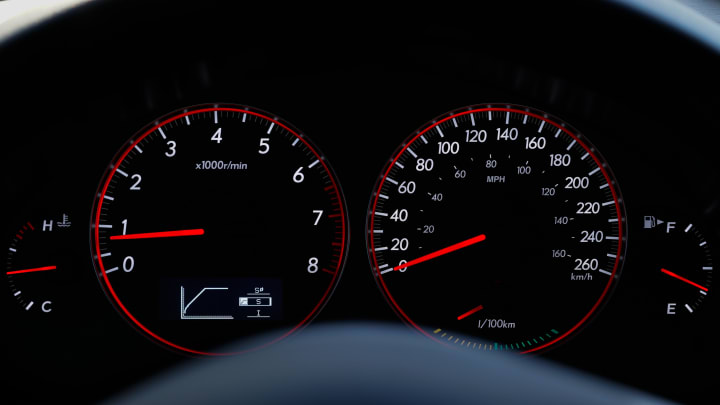10 Things You Didn't Know About Changing Your Oil
Whether you do it yourself or hire a professional mechanic, it's important to understand exactly what's going on when someone is changing your oil.

Not everyone is a "car person," and that's alright by me. Even if you don't have any particular interest in cars, however, there's still a good chance you own one. In fact, you probably use it almost every single day. If you own a car, you need to be in tune to its basic maintenance needs, and changing your oil is an integral part of those needs—among other car maintenance tips every driver should know. Whether you love learning about cars or you just want to know enough to take care of your daily mode of transportation, there are basic facts we should all know about our oil.
How often should you change your oil?

Photo by Fancycrave on Unsplash
Whether you change your oil (if you know how to change your oil) or you hire a mechanic, changing your oil regularly is one of the most important forms of maintenance you can perform on your vehicle. While different sizes of vehicle (e.g., compact cars, SUVs, large trucks) have slightly different needs, there are a few basic guidelines you should follow. Generally speaking, you should change your oil every 3,000 to 5,000 miles, or every three months or so. In addition to the size of your vehicle, this can vary depending on your environment. Urban areas with large amounts of stop-and-go traffic or dusty rural areas will cause more strain on your engine, which means you'll need to change your oil more frequently.
Black and gritty oil is not a good sign.

Photo by lee attwood on Unsplash
As a general rule, you should be checking the oil level in your vehicle on a regular basis. At the very least, however, you must check it any time you have any concerns about your car or are looking under the hood for any reason. To check your oil levels, all you need is a spare rag to wipe off the dipstick. Park your vehicle on level ground and turn off the engine. Pop your hood, locate the oil dipstick, and pull it out, using the rag to wipe it down. Insert and remove the dipstick again and check it to see how your oil level is. In addition to checking your levels, you should also be checking for color. New oil is almost golden in color. Dark oil and gritty oil are signs that it's time to get some fresh oil in your car.
A loud engine can mean it's time for a change.

Photo by Tim Mossholder on Unsplash
In addition to checking the oil level, there is a wide variety of different ways you can monitor your oil for when it may need to be changed. If your engine starts grinding or running more a little louder than normal, one of the first things you should do is check your oil levels. A loud engine is a strong sign that your oil may be running dangerously low. If the oil is relatively clean, you may be able to get away with simply topping it off, but a full oil change may be in order.
Frequent short trips take a heavy toll.

Photo by Alexander Popov on Unsplash
It may surprise you to learn that short trips in the car are actually bad for your vehicle. While long trips can take more of a toll on your lower back, a short drive means the engine never fully heats. As a result, your motor oil doesn't get hot enough to boil away any moisture that accumulates. Over time, this can cause serious damage unless you're constantly monitoring your oil and replacing the oil filter. If your daily commute is only a few minutes one way, it may be a good idea to start the engine early. If you run the engine for a few minutes before driving or take the scenic route to work, it will use up more gas, but may actually be healthier for your car in the long run.
Different oils work better for different vehicles.

Photo by Timothy Chan on Unsplash
If you're someone who has never tried changing your oil by yourself, you probably aren't overly familiar with the different varieties of oil on the market. In fact, you may not have even realized there are actually multiple different types of motor oil, and only a small subset of these types are appropriate for each vehicle. The most important measure is the viscosity grade, which looks something like "5W-30" or "20W-50." The higher the numbers, the higher the viscosity (the number before the "W" refers to the viscosity in cold weather). Thicker oil provides a better seal, but a lower viscosity allows the inner machinations of your engine to move faster. Luckily, there isn't usually a lot of room for creatively here: Consult your owner's manual and use whatever oil it recommends. Remember, not all oils are necessarily the same, so know how to purchase the best motor oil for your car.
What is the difference between natural and synthetic oil?

Photo by Zbynek Burival on Unsplash
Unlike viscosity grades, the choice between natural and synthetic oil is usually up to you as the vehicle owner. As their names suggest, natural oil (also known as "conventional" oil) is more or less naturally occurring, while synthetic oil is man-made with additional additives. For most vehicles, either type of oil works well enough. Synthetic oil, while more expensive than conventional oil, may make up for the cost in maintenance and performance savings. For example, natural oil should be changed every 3,000 miles or so, while some synthetic oils can go more than twice as long without being replaced. In addition to this, synthetic oils often lead to better fuel economy.
How does the oil light work?

Photo by Alan Biglow on Unsplash
There is a whole mess of lights and sensors on your dashboard that can seem like a bunch of nonsense if you aren't experienced with vehicles. Most of these lights (the check engine light, the fuel light, etc.) are there to notify you that something is wrong or that something needs maintenance. One of these lights—usually shaped like an oil can—is there to notify you when your oil needs to be changed. While it's important to be aware of this light, you should also know that it may not always be the most accurate indicator. These lights generally activate after your car has reached 3,000 miles (sometimes 4,000 to 5,000) since your last oil change. This doesn't necessarily take into account driving conditions or what type of oil you're using, so don't feel like you always have to trust that light.
Don't mess up the filter.

If you're changing your oil on your own, there are a few extra concerns you'll have to worry about. If you don't quite know what you're doing, replacing the oil filter can be more of an ordeal than any other aspect of the oil changing process. If you're going to tackle this, you need to have the right tools on hand, including proprietary oil filter wrenches to remove the oil filter and the right size of replacement oil filter. Additionally, you'll have to learn how to locate the oil filter and deal with removing the filter by hand.
More isn't always better.

To some well-intentioned, but poorly-informed makeshift mechanics, the quick-fix solution to any and all engine-related problems is to top off the oil. Adding new oil instead of changing your oil completely can be a smart move if your oil is running low, but only if it is still relatively clean. If your engine is already full of old, dirty oil, however, adding new oil will only exacerbate the issue. In fact, even if your engine is full of clean oil, too much oil can cause damage—no matter how clean it is! Adding too much oil to your vehicle can build up the pressure in your engine, compromising seals and gaskets and creating leaks.
Okay, but what does oil actually do?

Photo by Eduardo Flores on Unsplash
Even if you know how to monitor your oil, how often to check it, and changing your oil in general, are you familiar with what it actually does for your vehicle? The purpose of gasoline is somewhat obvious, as it functions as fuel for your vehicle. But motor oil isn't fuel, right? So what does it do? Essentially, there are three important functions of motor oil. First, it lubricates your engine; there are hundreds of moving parts in a car engine, so it's important they don't grind up against each other and cause damage. Second, motor oil helps regulate the temperature of your engine and keeps it from overheating. Finally, oil can carry away small debris like dirt and dust to keep it from clogging your engine.
About the Creator
Joseph D. N. Kendrick
Writer of words. Haver of cats. joeykendrick.com
Reader insights
Nice work
Very well written. Keep up the good work!
Top insight
Expert insights and opinions
Arguments were carefully researched and presented







Comments (1)
If you’re the type of person who waits for the engine light to come on before you check your oil, then chances are, you’ve already done irreplaceable damage. As the article states, changing your oil is the cheapest maintenance on your car. Smelling the stinky oil on your dipstick is also a telltale sign to change it. 👍